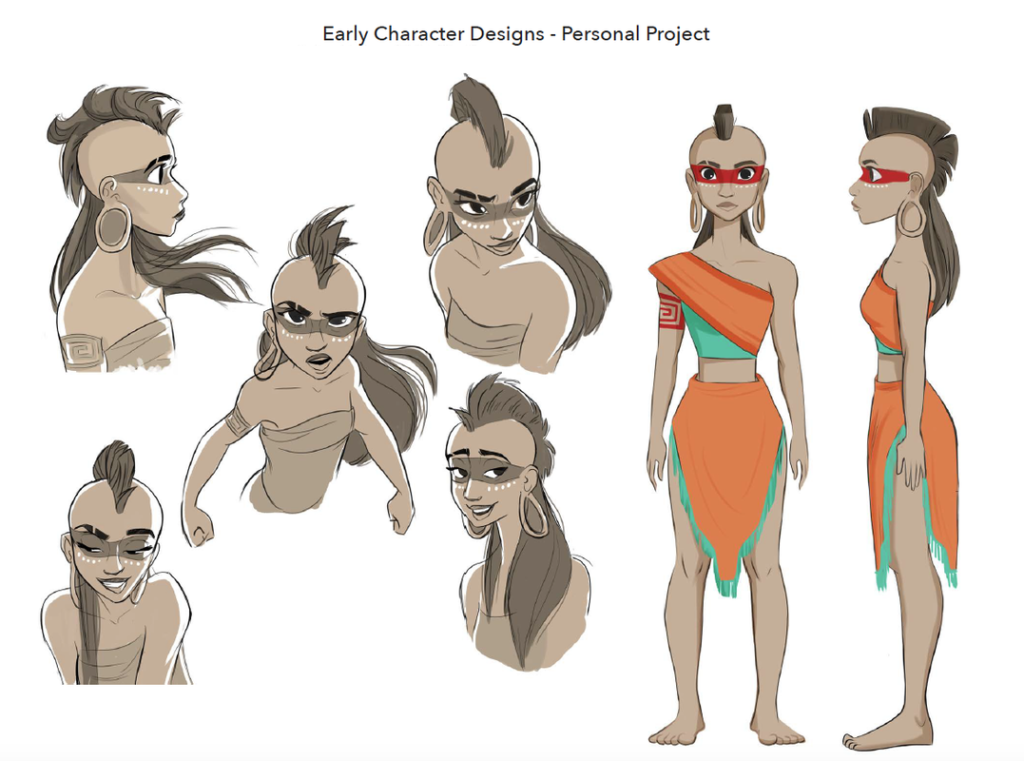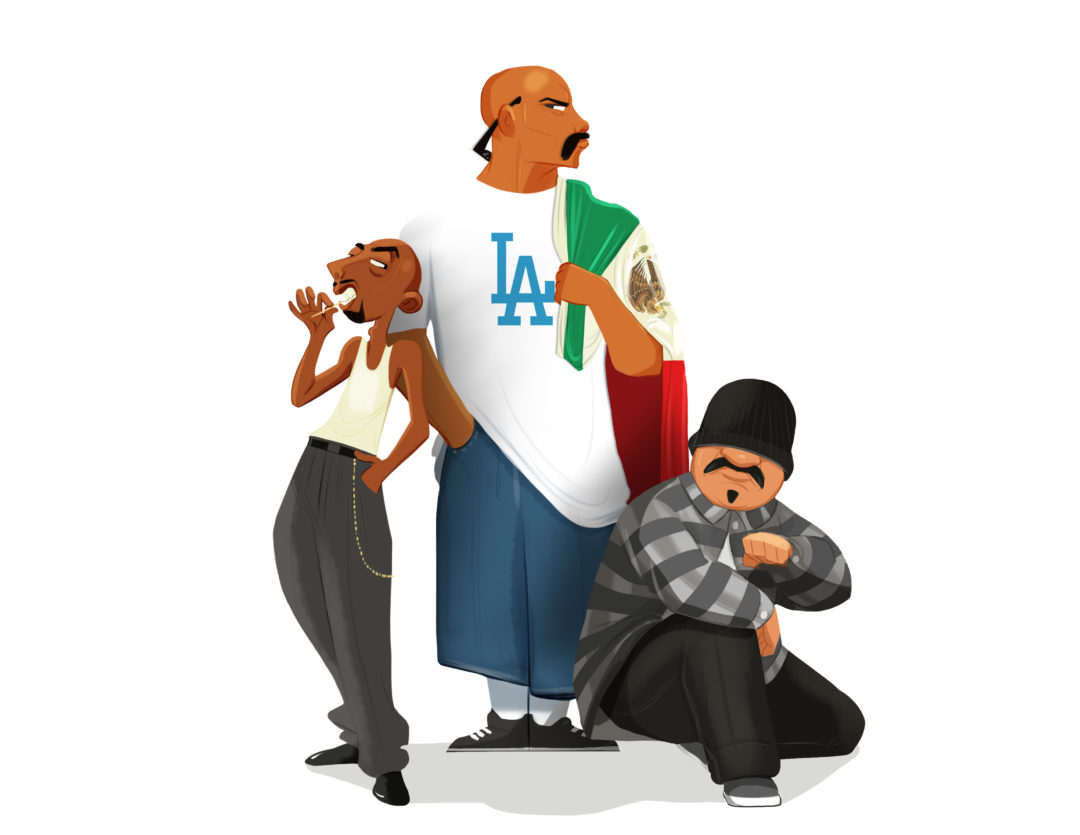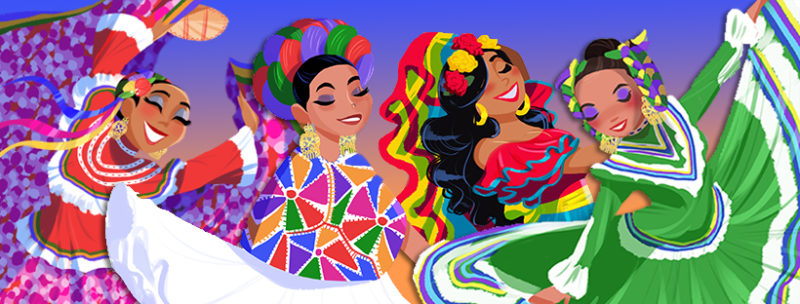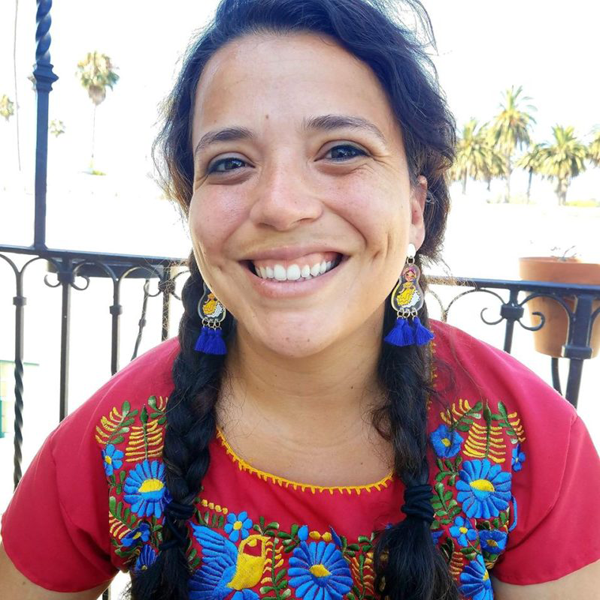January 2020 - Alicia Estrada
Alicia Estrada
Character Designer and Concept Artist
Character Designer and Concept Artist
Alicia Estrada is a Character Designer and Concept Artist from Burbank, CA. In 2014, she received her Bachelors degree in Animation from California State University, Northridge (CSUN). She has worked in consumer products as a Concept artist for Quantum Mechanix and most recently as a Junior Designer for Spin Master, Inc. Alicia enjoys drawing everyday and is dedicated to broaden her artistic skills in animation.
Our LXIA Member Spotlight this month focuses on Character Designer and Concept Artist, Alicia Estrada! Thank you for doing this interview. We are excited to learn more about you and the path you are on. Can you tell us more about yourself?
I’m humbled and honored to be even recognized, so thank you! I was born in West LA and grew up in the San Fernando Valley. I’ve been a dancer almost all my life, involved in my father’s Mexican Folklórico and Aztec dance group, Grupo Folklórico de West Los Angeles, and have performed at various events throughout California. Watching my parents perform along with their amazing group instilled in me the love for dance, music and art! I knew from a very early age that I wanted to be involved in the arts somehow and could never see myself doing anything else.
Thanks to my wonderful grandparents I learned basic Spanish, but never practiced it at school or later at work. I grew up as one of those Mexican-American kids who understood Spanish but couldn’t speak it. For a long time I felt ashamed that I couldn’t speak the language but now I embrace who I am despite circumstances with the language barrier and have discovered more people like me who grew up never learning the language. Performing Mexican Folklórico dance really helped me to embrace my culture, my heritage and family history, even if I couldn’t speak the language well!
“It’s important to also make sure your drawings are appealing, clear and easy to interpret what’s going on.”
What made you want to become a character designer and concept artist? Can you explain the differences between these disciplines? Do you prefer one over the other?
I remember being 9-years-old watching Disney movies on VHS and the “Making of the Film” featurettes or TV documentaries, and learning about how they made an animated film, all the drawings involved, etc. I’ve known since then that working in animation is what I want to do! Specifically, I wanted to draw characters from my favorite animated films. I would grab a paper and a pencil, play the video and hit pause on characters or moments from the film and draw them! I did this for a long time and still have an entire sketchbook with all of that work.
For Christmas one year, I was given the best gift: three huge Disney art books on The Art of The Hunchback of Notre Dame, The Art of Pocahontas and The Art of The Lion King. I read those books at least ten times each, studying each page and reading all about the process of designing characters, and THAT’S what sparked my great interest in character design. I also LOVED all the character concept art before they chose the final look of the character for the film.
A character designer, in general, is also a concept artist because when designing a character an artist can draw several different interpretations of the character, giving the director options for how the character can look in the film. You can also be a concept artist for environments, prop design or toy design. I think what separates the two disciplines is mainly what you’re being hired on for. For example, you can be hired on a project for creating concepts for a character, but the final look, turnarounds and character model sheets are done by the lead character designer. Whichever discipline you strive to be, as a 2D artist, it requires lots of drawing practice! You really have to love and have a passion for drawing to be a character designer or concept artist. It’s important to also make sure your drawings are appealing, clear and easy to interpret what’s going on. I’ve also learned to not become too attached to a drawing when presenting to a director. You may love a particular version you designed, but the director may not, so it’s important to be open to critique and feedback.

Tell us about your style, it seems you have a blend of various influences and yet they are really unique to you. What were some of those influences growing up and how did you come into your own style as an artist in general?
I have so many artistic influences, almost too many to write, but I will begin with my grandfather being my first artistic inspiration. He has so many acrylic and oil paintings hung up in his house and so many others in his garage that can have his own art exhibition someday! I admire his love for painting towns, landscapes, portraits and random objects. They are so beautiful! He always taught me to “draw lightly and don’t go too dark right away”. This was my first art lesson; he was my first art teacher.
Aside from watching Disney cartoons and films, I loved watching the Sailor Moon series as a kid, which at the time inspired me to start drawing anime style characters. Over the years, my drawings have changed and don’t look as “anime” as before, but I do like and incorporate the simplicity and appeal of that particular style. I loved studying the old masters in my CSUN Art History classes; Da Vinci, Michelangelo, Caravaggio, Rembrandt, and Bernini, just to name a few. These artists invoked such feeling and emotion in their work, which I always strive to bring to my drawings no matter what characters I design. It’s hard to talk about my influences in character design without mentioning legendary Disney artists such as Marc Davis, Milt Khal, Glen Keane, Andreas Deja, Eric Goldberg, Mary and Preston Blair, Kathy Zielinski and Cory Loftis, also to name a few. All of these artists have greatly influenced my artwork, but also how I approach character design.

When it comes to creating a character what is your process? What are some of the challenges that come with creating characters and what makes it fun?
When it comes to creating a character, I like to read the script to get a sense of the character(s) personality and where they are coming from. I like to write on sticky notes and jot down important information I find about the character. I gather images online to use as reference for clothing, hairstyle, color, or anything that would help in development. Once I have all this information, I do rough sketches or thumbnails of possible artistic directions I can take with the character. I think drawing out all the concepts of how the character can look is the most fun for me because this is where I feel a great sense of artistic freedom as a character designer. It’s fun to explore those variations!
One of the challenges I face as a character designer, or just in general as an artist, is that there are days when nothing I draw looks good to me. Sometimes the concept I see in my head does not translate well on paper! Those days are tough but I always get up and take a break from work and do something else. I walk my dog, watch TV, go to the gym, or anything to give myself a mental break, then later I’ll go back to the drawings with a fresh outlook.
On top of being an artist, you are also a professional folklórico dancer and it shows in some of your work. How does dancing folklórico influence your art? What other creative outlets do you enjoy?
It affects my work immensely!! They go hand in hand for me. As a dancer, I understand movement and performance, which has given me the artistic skill set to capture movement in my drawings very easily. I also understand the feeling of expression in performance, so as I’m drawing my characters expressions, I act it out for my camera and use it for reference later. The various costume dresses I wear gives me a sense of how clothing might be worn on a character based on the weight and fit of the clothing. It all helps to tell the character’s story!
Aside from being a freelance artist, I teach Zumba classes during the week in Burbank and the San Fernando Valley. It keeps me active and it’s a nice break from working on the computer!
“Representation is very important in animation because you never know who you are inspiring behind the lens or behind your drawings. I was THAT 9-year-old little girl watching these great animators discuss their work on TV. “
There is a huge push for more representation in general. When it comes to your art, how important is representation to you not only as a latino but also as a woman?
Representation is very important in animation because you never know who you are inspiring behind the lens or behind your drawings. I was THAT 9-year-old little girl watching these great animators discuss their work on TV. It was inspiring to see a woman like Kathy Zielinski, who was a Disney lead animator, talk about her most iconic characters or when I see someone like Jorge Gutierrez, a Latino, directing films like The Book of Life. It’s exciting to see women and latinos being represented! It means their voices are being heard and what they contribute matters. I’m happy that the animation industry is taking steps in the right direction because we all have stories to tell.
Can you tell us about “Life with Liam” and/or other projects are you currently working on?
“Life with Liam” are drawings of special moments or funny situations I’ve had with my dog, Liam. It’s a project I hope to turn into a webcomic very soon. There are only a few listed on my website, but there are many more funny and sweet moments I hope to produce soon.
At the moment, I’ve been commissioned to work on character designs for a few animated projects that I’m excited about and will hopefully share sometime next year. I also have some story ideas of my own that I am developing and designing to include in my portfolio…. all while continuing to work in freelance!
Thank you for interviewing with us, Alicia!

FollowAlicia Estrada on social media!

